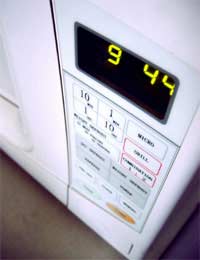
Defrosting food safely is essential in preventing food poisoning. Here’s our guide to safe defrosting.
How Safe Defrosting Prevents Food Poisoning
In the UK, around 80,000 people suffer from food poisoning every year (Health Protection Agency Centre for Infections, 2005). It’s caused by the presence of certain bacteria, including E.Coli, in food that has not been prepared properly. But incidence of food poisoning is decreasing – and you can take measures to stay safe at home.
When you freeze food, the bacteria inside it is rendered dormant by the cold temperature. This bacteria is destroyed in proper cooking. However, if you have not defrosted the food properly, the recommended cooking time may not be sufficient to destroy bacteria – which can result in food poisoning. Not defrosting safely is one of the main causes of food poisoning in the UK, where we depend on freezers to store many foods before cooking.
Safe Defrosting Rules
Many modern kitchens are not designed with energy efficiency in mind. Disguising your fridge behind a door or putting it under a worktop do not give the fridge sufficient ventilation, and should really be avoided if possible. If you do have the choice of where to site your new fridge (for instance if you’re redesigning the whole kitchen), try to pick a place that’s out of direct sunlight and well away from hot appliances like kettles and ovens. This isn’t always possible, but it will help.
Defrosting in the fridge is the safest option. Put the wrapped, frozen food on a shelf that’s not too crowded – or a bottom shelf for raw meat – and leave it overnight to thaw slowly.
Defrosting in a microwave will speed up the process. But be careful to ensure that the food is thoroughly thawed: turn or stir it to make sure there are no frozen bits at the bottom. When you have thawed food using a microwave’s defrost setting, you must cook it immediately afterwards. If you are defrosting small portions such as chicken breast or sausages, try putting them into a sealed bag and placing in a sink of cold water – the defrost time will speed up. When using this method, cook the thawed portions straightaway.
Discard the liquid from defrosting food – it may carry bacteria, and should be safely disposed of, and not allowed anywhere near any other foods.
Cook defrosted food immediately, or you may allow bacteria to breed inside it.
Defrosting Your Christmas Turkey
A turkey usually takes a long time to defrost – the Food Standards agency suggests that you should allow 10-12 hours per kilogram of meat. Defrosting can be done in a fridge, cool room, or garage – which is handy when your fridge is stuffed full with other things. Unwrap the turkey and take out the giblets before placing it on a large dish or tray. Cover the turkey with clean clingfilm and keep a watch on it – you will probably need to tip away the juices that seep out as the turkey defrosts. Wash your hands before and after touching the raw turkey.
The turkey’s packaging usually carries instructions for defrosting, including an estimated time-scale. Make sure the turkey is defrosted by checking for ice inside the cavity.
